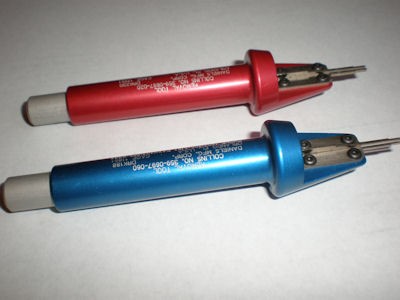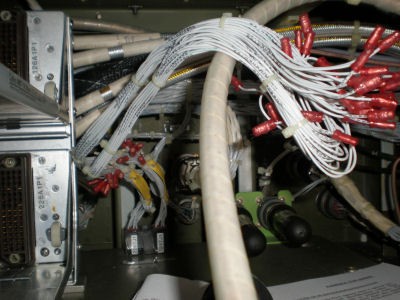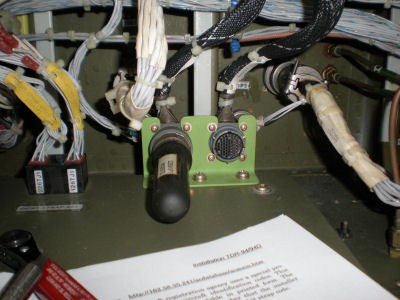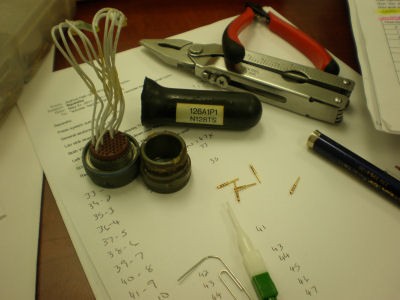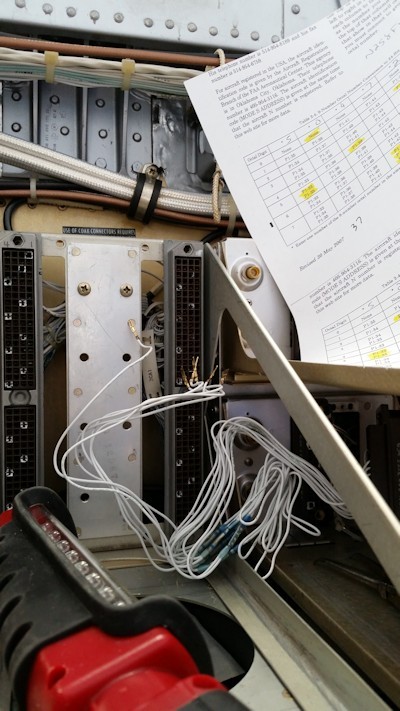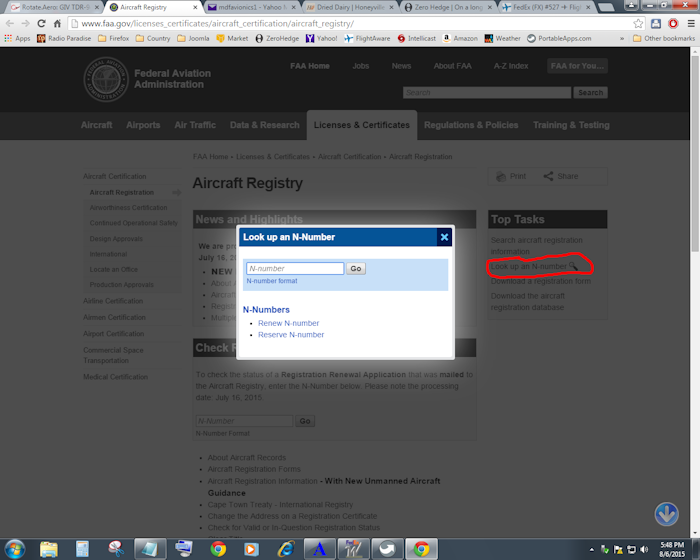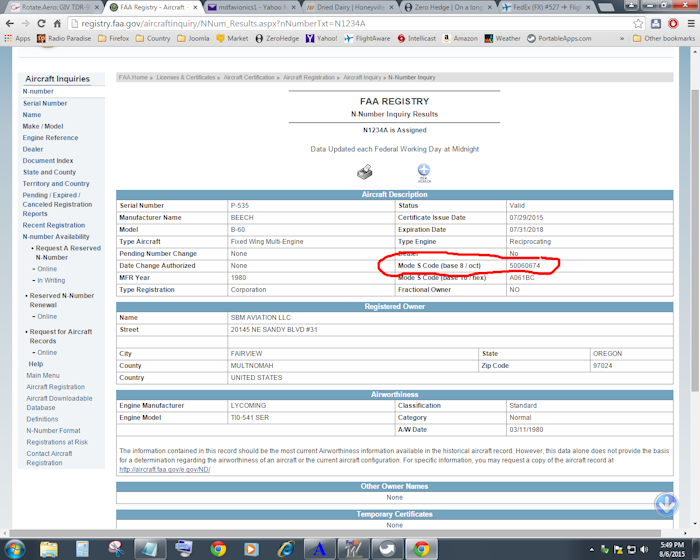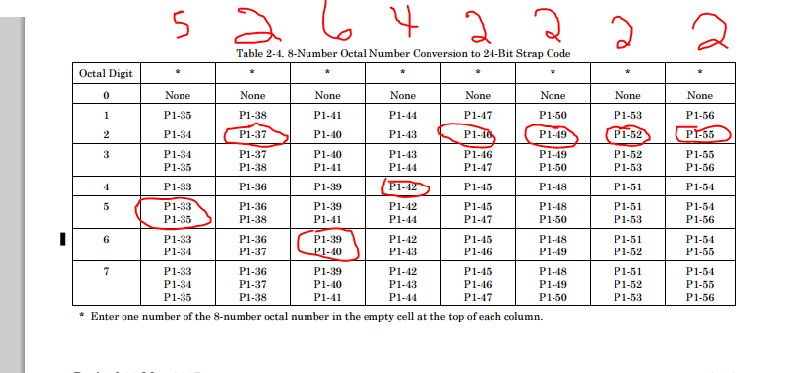- Posts: 1081
- Thank you received: 188
GIV TDR-94 Strapping
11 years 3 months ago - 11 years 3 months ago #27
by Mark
GIV TDR-94 Strapping was created by Mark
Collins
TDR-94 ATC Transponders
are found on numerous aircraft types. They are extremely reliable units and are rarely pulled for failure. One particular job that does need to be performed on the units is a code strapping reconfiguration whenever the aircraft registration (in the U.S., the “N” number) changes. Strapping can be done at the rack plugs or at an external terminal block. Older aircraft tend to accomplish this at the plugs. Newer aircraft, such as this particular GIV have an external strapping junction.
The transponders on a GIV are located under the radome, aircraft left, on the top shelf.
Rack plugs. Strapping is accomplished on the P-1 plug, pins 33 through 56. This generation of rack plugs from Collins uses a flat “fork” terminal that is quite different than the normal type plug that uses round pins. Of course, working with these pins requires a special crimper and removal tools. These are “push out” terminals and they are removed from the rear of the rack plug. The numbering on these plugs can also be tricky. Viewing from the front side: Pin 1 is upper right. Successive pins are read right to left for each row. Pin 5 would be directly below pin 1.
This aircraft has two junction blocks on the outboard side of the racks. Normal thinking would tend to lead to the strapping being done at the blocks. After the wire bundles were opened up, the terminal block wiring led to numerous (disconnected) capped off pins.
Tracing wires revealed the coding is accomplished at two removable jumper plugs. This is quite a handy option. The jumpers can be removed and recoded in a shop environment instead of messing with rack plug pins or onboard terminal blocks. These two were most likely assembled at Gulfstream and probably are attainable from them, at a cost.
Coding for these plugs took a little chart. The pins on the plug did not match the pins on the rack. They were “32” off. Pin 33 on the rack matched pin 1 of the plug
.
(I found that pin 25 was connected to the jumper array. I did not continuity check this to a corresponding rack plug pin, but it must be an actual “ground” provided by the TDR-94 when it is in the rack.)
The transponders on a GIV are located under the radome, aircraft left, on the top shelf.
Rack plugs. Strapping is accomplished on the P-1 plug, pins 33 through 56. This generation of rack plugs from Collins uses a flat “fork” terminal that is quite different than the normal type plug that uses round pins. Of course, working with these pins requires a special crimper and removal tools. These are “push out” terminals and they are removed from the rear of the rack plug. The numbering on these plugs can also be tricky. Viewing from the front side: Pin 1 is upper right. Successive pins are read right to left for each row. Pin 5 would be directly below pin 1.
This aircraft has two junction blocks on the outboard side of the racks. Normal thinking would tend to lead to the strapping being done at the blocks. After the wire bundles were opened up, the terminal block wiring led to numerous (disconnected) capped off pins.
Tracing wires revealed the coding is accomplished at two removable jumper plugs. This is quite a handy option. The jumpers can be removed and recoded in a shop environment instead of messing with rack plug pins or onboard terminal blocks. These two were most likely assembled at Gulfstream and probably are attainable from them, at a cost.
Coding for these plugs took a little chart. The pins on the plug did not match the pins on the rack. They were “32” off. Pin 33 on the rack matched pin 1 of the plug
.
(I found that pin 25 was connected to the jumper array. I did not continuity check this to a corresponding rack plug pin, but it must be an actual “ground” provided by the TDR-94 when it is in the rack.)
Last edit: 11 years 3 months ago by Mark.
Please Log in or Create an account to join the conversation.
11 years 3 months ago - 11 years 3 months ago #28
by Mark
Replied by Mark on topic GIV TDR-94 Strapping
Octal codes for each registration number can be found through this
FAA web page
. The Mode “S” Code is displayed after the new aircraft registration number is entered. The eight digits are placed in the top row of the chart below to ascertain the correct jumpers.
Last edit: 11 years 3 months ago by Mark.
The following user(s) said Thank You: hawker700
Please Log in or Create an account to join the conversation.
11 years 1 month ago #32
by Mark
Replied by Mark on topic GIV TDR-94 Strapping
I recently changed the "N" number on another aircraft. This one was a Falcon-50. The transponders are located inside the radome on the top shelf. I was lucky to be able to pull out the strapping bundles for both upper and lower racks (the racks themselves looked to be a bear to remove). There was enough room to manipulate the plugs in such a way to push out and swap the pins. I also got lucky by the fact that the new number required three less pins (which meant no diking/splicing). I applied heat shrink to the unused pins and tucked them back with the bundle for the next guy who changes the number again.
It "was" a big deal to get the damn thing to test. Despite insistence from the mechanic in charge of the aircraft, we did have to place it in the air mode for the transponders to reply to the test unit. I didn't check into it, but there was some mod done on them to keep them active on the ground. Either the mod was done wrong or I'm missing the "big" picture as to the functionality of it. (Most likely..... my stupidity)
It "was" a big deal to get the damn thing to test. Despite insistence from the mechanic in charge of the aircraft, we did have to place it in the air mode for the transponders to reply to the test unit. I didn't check into it, but there was some mod done on them to keep them active on the ground. Either the mod was done wrong or I'm missing the "big" picture as to the functionality of it. (Most likely..... my stupidity)
Please Log in or Create an account to join the conversation.
10 years 4 months ago - 10 years 4 months ago #119
by Mark
Replied by Mark on topic GIV TDR-94 Strapping
Last edit: 10 years 4 months ago by Mark.
Please Log in or Create an account to join the conversation.
10 years 3 months ago #122
by hawker700
Replied by hawker700 on topic GIV TDR-94 Strapping
Hi Mark,
May I know whats document are you using?
I need to strap my TDR-94D, but I have no reference material.
Your attachment will help me, but I dont know the pin where should I remove or add.
If possible, can you share with me your reference manuals?
Thanks.
May I know whats document are you using?
I need to strap my TDR-94D, but I have no reference material.
Your attachment will help me, but I dont know the pin where should I remove or add.
If possible, can you share with me your reference manuals?
Thanks.
Please Log in or Create an account to join the conversation.
10 years 3 months ago - 10 years 3 months ago #123
by Mark
Replied by Mark on topic GIV TDR-94 Strapping
The only document I've ever used for the TDR-94D is
rotate.aero/media/kunena/attachments/936...neIIIM5230772719.pdf
You need two copy's. On one, highlight the pins of the current octal configuration. On the second highlight the pins of the new configuration. Then just compare what pins need to be added or removed for each octal number. You'll find that some pins don't even need to be messed with. Each octal digit will have 0,1,2, or 3 wires hooked up. You just need to compare each of the eight digits across. Some you lose pins (example: only need two instead of three), on other digits you might have to add a pin. ALL the pins connect to ground.
The BIG issue is if you need to add to the total number of pins. You must have spare pins.
Is this a Hawker? Can you give me the old and new "N" numbers?
rotate.aero/media/kunena/attachments/936...neIIIM5230772719.pdf
You need two copy's. On one, highlight the pins of the current octal configuration. On the second highlight the pins of the new configuration. Then just compare what pins need to be added or removed for each octal number. You'll find that some pins don't even need to be messed with. Each octal digit will have 0,1,2, or 3 wires hooked up. You just need to compare each of the eight digits across. Some you lose pins (example: only need two instead of three), on other digits you might have to add a pin. ALL the pins connect to ground.
The BIG issue is if you need to add to the total number of pins. You must have spare pins.
Is this a Hawker? Can you give me the old and new "N" numbers?
Last edit: 10 years 3 months ago by Mark.
The following user(s) said Thank You: hawker700
Please Log in or Create an account to join the conversation.
10 years 3 months ago #124
by hawker700
Replied by hawker700 on topic GIV TDR-94 Strapping
Thanks Mark.
Really appreciated it.
Yes, It is Hawker. previous N registered is N825MS and now is under Philipines reg. and planned to dereg to 9M- reg.
The problem is, I have no other reference or current octal code right now.
What you mean is, I need to reverse the step, looking for which pin are inserted now, then compare it to new octal?
BTW, should the pins on the rear TDR is same manner regarding of the aircraft,right? so I just simply use your docs uploaded previously.
Really appreciated it.
Yes, It is Hawker. previous N registered is N825MS and now is under Philipines reg. and planned to dereg to 9M- reg.
The problem is, I have no other reference or current octal code right now.
What you mean is, I need to reverse the step, looking for which pin are inserted now, then compare it to new octal?
BTW, should the pins on the rear TDR is same manner regarding of the aircraft,right? so I just simply use your docs uploaded previously.
Please Log in or Create an account to join the conversation.
10 years 3 months ago - 10 years 3 months ago #125
by Mark
Replied by Mark on topic GIV TDR-94 Strapping
The old "N" number octal is 52642222 which I found here
registry.faa.gov/aircraftinquiry/NNum_Re...px?nNumberTxt=n825ms
You'll have to contact the aviation authority in your country for the new octal code.
Both transponders use the same code strapping. From the chart, you have a lot of octal codes with only one pin. Hopefully there are some spares tie-wrapped in the back that you can use. If not, you'll need to get some spare pins from somewhere.
Do you have the extraction tool???? You're not doing any change-over without it. And..... make sure the pins lock into place when you insert them, they can be tricky.
(I'm not dyslexic, the numbers drawn in above where done with a computer mouse.)
You'll have to contact the aviation authority in your country for the new octal code.
Both transponders use the same code strapping. From the chart, you have a lot of octal codes with only one pin. Hopefully there are some spares tie-wrapped in the back that you can use. If not, you'll need to get some spare pins from somewhere.
Do you have the extraction tool???? You're not doing any change-over without it. And..... make sure the pins lock into place when you insert them, they can be tricky.
(I'm not dyslexic, the numbers drawn in above where done with a computer mouse.)
Last edit: 10 years 3 months ago by Mark.
The following user(s) said Thank You: hawker700
Please Log in or Create an account to join the conversation.
10 years 3 months ago - 10 years 3 months ago #126
by hawker700
Replied by hawker700 on topic GIV TDR-94 Strapping
Later I'll compare to current strapping pin position, if it is still the same like previous reg., if yes, it is lucky for me because no other BIG work to do. If not, I have to look on the pin itself to find the current octal code.
About the tools, can you give me P/N of it? Insertion and extraction.
For the pins, I reckon, I just look on the P/N on the current pins (if I have extracted one).
I will update to you once I settled this things.
For now, many thanks tou you Mark for helping me.
About the tools, can you give me P/N of it? Insertion and extraction.
For the pins, I reckon, I just look on the P/N on the current pins (if I have extracted one).
I will update to you once I settled this things.
For now, many thanks tou you Mark for helping me.
Last edit: 10 years 3 months ago by hawker700.
Please Log in or Create an account to join the conversation.
10 years 3 months ago #127
by Mark
Replied by Mark on topic GIV TDR-94 Strapping
There will be no P/N on the pins.
I'll look for part numbers for both the extraction tool and pins tomorrow and get back to you on this post.
I'll look for part numbers for both the extraction tool and pins tomorrow and get back to you on this post.
Please Log in or Create an account to join the conversation.
Time to create page: 1.023 seconds
Don't have an account?
Register now to join the community!
©
2025
Rotate.Aero



